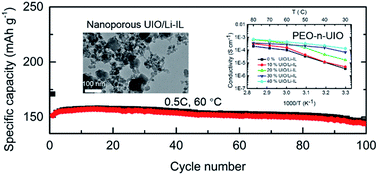MOF-derived nanoporous multifunctional fillers enhancing the performances of polymer electrolytes for solid-state lithium batteries†
Abstract
Polymer electrolytes usually suffer from low ionic conductivity and poor stability against the lithium electrode. Taking advantage of nanostructured metal–organic frameworks (MOFs), novel nanoporous fillers, i.e., UIO/Li-IL, are developed for polymer electrolytes; in UIO/Li-IL, a Li-containing ionic liquid (Li-IL) is absorbed in UIO-66 MOFs. These fillers are multifunctional: high ionic conductivity and capability to suppress the crystallinity and to improve the stability of polyethylene oxide (PEO) against the lithium electrode. PEO-n-UIO composite polymer electrolytes are formed by dispersing the multifunctional fillers in PEO; the conductivity of the PEO-n-UIO solid electrolytes is increased by a factor of ∼37 to 1.3 × 10−4 S cm−1 at 30 °C with 40% UIO/Li-IL, and the current density for stable Li plating/stripping in PEO-n-UIO solid electrolytes is enhanced to 500 μA cm−2 at 60 °C. Solid-state lithium batteries based on the PEO-n-UIO solid electrolyte show an initial discharge capacity of ∼151 mA h g−1 with a capacity retention of 95% after 100 cycles at 0.5C and 60 °C. Our work pioneers novel multifunctional fillers to boost the performances of composite polymer electrolytes for high energy density, safe and long lifetime energy storage systems.



 Please wait while we load your content...
Please wait while we load your content...